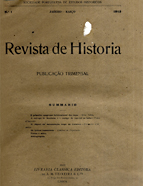

................................
In any case, over the years of publication, and as a faithful echo of its self-assessment, we note the publication in RH of sources (official documents, letters, among others) and interpretative articles. With regard to the publication of sources, few contributors failed to do so. Fidelino, on more than one occasion, published unpublished letters by Eça de Queiroz and Alexandre Herculano, which is not surprising, given their literary themes and historiographical references. However, those who most embraced this type of publication were Pedro de Azevedo and António Baião, which is understandable considering their professions (archivists and palaeographers). There are works of a more reflective nature, such as those by Benedetto Croce or the then young Francisco Vieira de Almeida, which dealt with epistemological aspects of historiographical work (vol. 3). New perspectives were presented on much-debated topics, such as João Lúcio de Azevedo’s take on the figure of the Marquis of Pombal. Other works represented a first step towards more brilliant studies, such as João Lúcio de Azevedo’s studies on the new Christians in the “ “ or Fortunato de Almeida’s notes for his History of the Church. There was also room for controversy/criticism among members of the SPEH (although few), which were echoed in the RH, such as between Fidelino de Figueiredo and António Prado Coelho on Balzac (vols. 2 and 3).
In line with a certain trend at the time, the Modern and Contemporary periods were the most recurrent. This can be explained to a large extent by the topics covered, namely political, religious, maritime and literary history. Other areas, such as archaeology and ethnography, occupy a residual space. Mention should also be made of regional and local history studies, which were substantial, in keeping with the nineteenth-century tradition of this type of work. However, in order to understand the volume of the most recurring themes, we must take into account that those who worked hardest on the above-mentioned themes were precisely those figures who produced the most intensively throughout the journal’s existence, such as Fidelino de Figueiredo, Fortunato de Almeida, João Lúcio de Azevedo and Edgar Prestage. Biography was a recurring theme, with almost all the major authors presenting works (Brito, Idem, p. 70).
This work is financed by national funds through FCT - Foundation for Science and Technology, I.P, in the scope of the projects UIDB/04311/2020 and UIDP/04311/2020.
